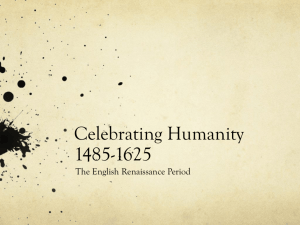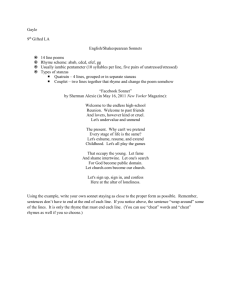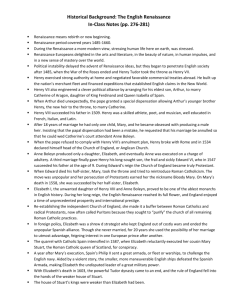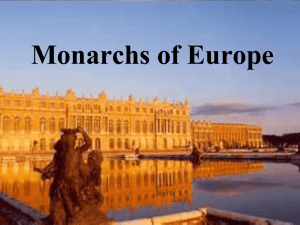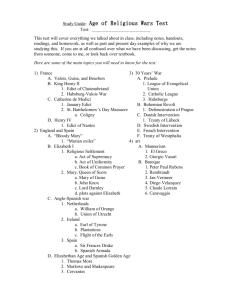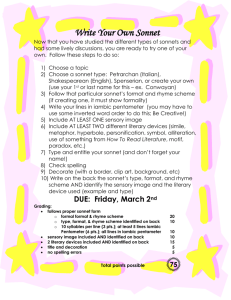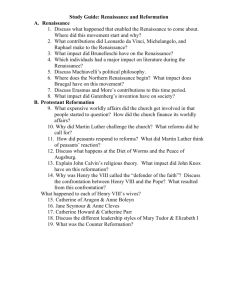The Renaissance
advertisement
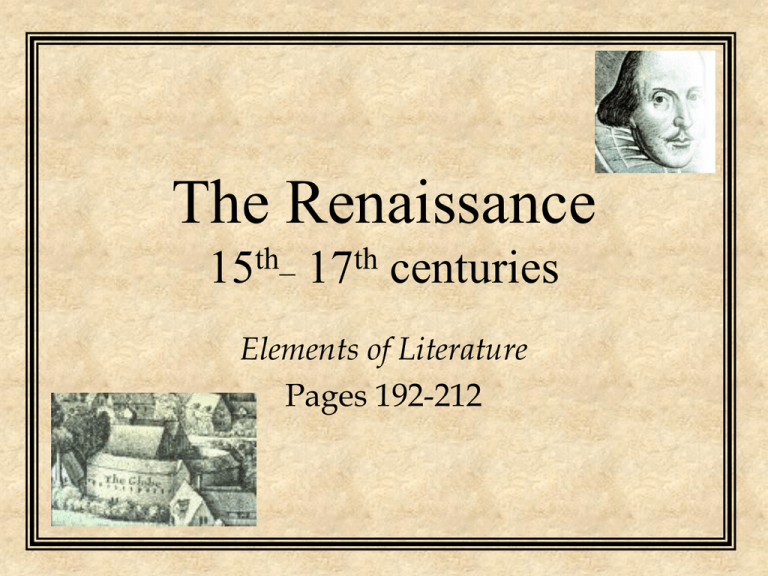
The Renaissance 15th_ 17th centuries Elements of Literature Pages 192-212 What was the Renaissance? • Beginning in the late 1400s, the English Renaissance marked changes in people’s values, beliefs, and behavior. • Renaissance=Rebirth – There was a renewed interest in the classical studies of Greek and Roman cultures (neoclassicism). – People generally became more curious! More people learned to read and studied themselves and the world around them. • “The Renaissance Man” It All Began in Italy • Vasco de Gama’s voyage to India in1498 spurred a new system of trade and interaction between East and West. • Michealangelo, da Vinci, Galileo, Dante Alegheri, Botticelli… They were all Italian. • Influence of the Church– The Sistine Chapel (14731481) The Ceiling of the Sistine Chapel Humanism: What is a human being? • What was humanism? – an intellectual movement answering life’s tough questions concerning we humans • Harmony between intellect and religion? Thomas More Deiderius Erasmus God Bless Gutenberg! • Johannes Gutenberg and his HUGE Bible (1455) • One book on one printing press led to more printing presses and more books and more printing presses and more books… • By 1500, relatively inexpensive books were available throughout Europe—Effect: Literacy! Thomas More and His Utopia • 1516: More, a well-known humanist published Utopia, a narrative describing a perfect world (irony of name). The Protestant Reformation: a Break in the Church • Before the Reformation, if you were Christian, you were Catholic.. There was nothing else in Christianity! • Martin Luther in Worms, Germany – “Superstition, idolatry, and hypocrisy have ample wages, but truth goes a-begging.” • Sign of the times: new thought rebuking longstanding traditions… There would be an effect on religion! I’m Henry the Eighth I am… King Versus Pope: All for an Heir • Kings of England and popes have been fighting for generations.. but it all came to a boil with Henry • Here’s the deal: Henry wanted a son to pass down the throne, but none of his wives bore him one… Henry wanted a divorce, but the Pope wouldn’t give him one… • 1531, Henry: “I’m starting my own church– the Church of England.” The Wives of Henry VIII Anne Boleyn Jane Seymour (Beheaded) (Died) Anne of Cleves Catherine Howard Catherine Parr (Divorced) (Beheaded) (Survived) Catherine of Aragon (Divorced) Henry’s Children • Mary Tudor: daughter of Catherine of Aragon; known as Bloody Mary (we’re getting to that) • Elizabeth: daughter of Anne Boleyn; I’m sure you’ve all heard of her. • Edward: son of Jane Seymour; Because of the laws of succession, he was crowned first, but he only ruled for six years before dying. Mary Tudor a.k.a. Bloody Mary • She took the throne when Edward died in 1553. • Mary was a devout, strongwilled Catholic (remember who her mother was?!) • She restored the pope’s power in England… and also burned about three hundred British subjects at the stake for remaining openly protestant. • Married King Philip II of Spain, but she died without children… So who takes the throne? Good Queen Bess • Remembered as one of the most brilliant and successful monarchs in history • Her first task: reestablish law and order in England! – Reinstated the Church of England • Married to the state • Strong will and nine lives? The Spanish Armada • Because of Elizabeth’s refusal to marry Philip (exbrother-in-law) and also the execution of Mary Queen of Scots, Spain did not really like Elizabeth very much. • In 1588, Philip assembled the Spanish Armada, and attempted to attack England. – Elizabeth proved herself! Connection to Literature? • During the Renaissance, England (and Elizabeth) became a symbol of peace and a haven in Europe. – Elizabeth was the inspiration for and the patron of many longlasting pieces of literature from this time period. (The Faerie Queene) The End of an Era • When Elizabeth died in 1603, the Renaissance in England began to die with her. • She was succeeded by her Scottish cousin James I (daughter of Mary Queen of Scots). • James was succeeded by Charles I, whose time on the throne led to the English Civil War during the 17th Century. Sonnets • A sonnet is a fourteen-line poem following a set rhyme scheme. • Rhyme schemes are found by looking at the last word of a line of poetry and labeling it with corresponding letters of the alphabet, starting with “A.” • The sonnet form is what named arrangement a sonnet fits– Petrarchan, Spenserian, or Shakespearean. Petrarchan (Italian) • Developed by the Italian poet Petrarch • Only the first eight lines, or octave, have a set pattern: ABBAABBA • After the octave, there is a turn, a change in tone or subject matter. • Always find the rhyme scheme for all fourteen lines, but if you see the ABBAABBA, it’s Petrarchan! Spenserian • Developed by Renaissance poet Edmund Spenser • Divided into three quatrains (four lines) and one couplet (two back-to-back lines that rhyme): ABAB BCBC CDCD EE • Here’s a memory trick: Remember the EE for Edmund Spenser! Shakespearean • Developed by William Shakespeare • Like Spenserian, this sonnet has three quatrains and a couplet. Like Petrarchan, it also has a turn at line nine. • Here is its rhyme scheme: ABAB CDCD EFEF GG Whoso List To Hunt- Sir Thomas Wyatt Whoso list to hunt, I know where is an hind, But as for me, alas, I may no more. The vain travail hath wearied me so sore, I am of them that farthest cometh behind. Yet may I by no means my wearied mind Draw from the deer, but as she fleeth afore Fainting I follow. I leave off therefore, Since in a net I seek to hold the wind. Who list her hunt, I put him out of doubt, As well as I may spend his time in vain. And graven with diamonds in letters plain There is written, her fair neck round about: Noli me tangere, for Caesar's I am, And wild for to hold, though I seem tame. Sonnet 30 My love is like to ice, and I to fire: How comes it then that this her cold so great Is not dissolved through my so hot desire, But harder grows the more I her entreat? Or how comes it that my exceeding heat Is not allayed by her heart-frozen cold, But that I burn much more in boiling sweat, And feel my flames augmented manifold? What more miraculous thing may be told, That fire, which all things melts, should harden ice, And ice, which is congeals with senseless cold, Should kindle fire by wonderful device? Such is the power of love in gentle mind, That it can alter all the course of kind. Sonnet 18 Shall I compare thee to a summer's day? Thou art more lovely and more temperate; Rough winds do shake the darling buds of May, And summer's lease hath all too short a date; Sometime too hot the eye of heaven shines, And often is his gold complexion dimm'd; And every fair from fair sometime declines, By chance or nature's changing course untrimm'd; But thy eternal summer shall not fade, Nor lose possession of that fair thou ow'st; Nor shall Death brag thou wander'st in his shade, When in eternal lines to time thou grow'st: So long as men can breathe or eyes can see, So long lives this, and this gives life to thee.
